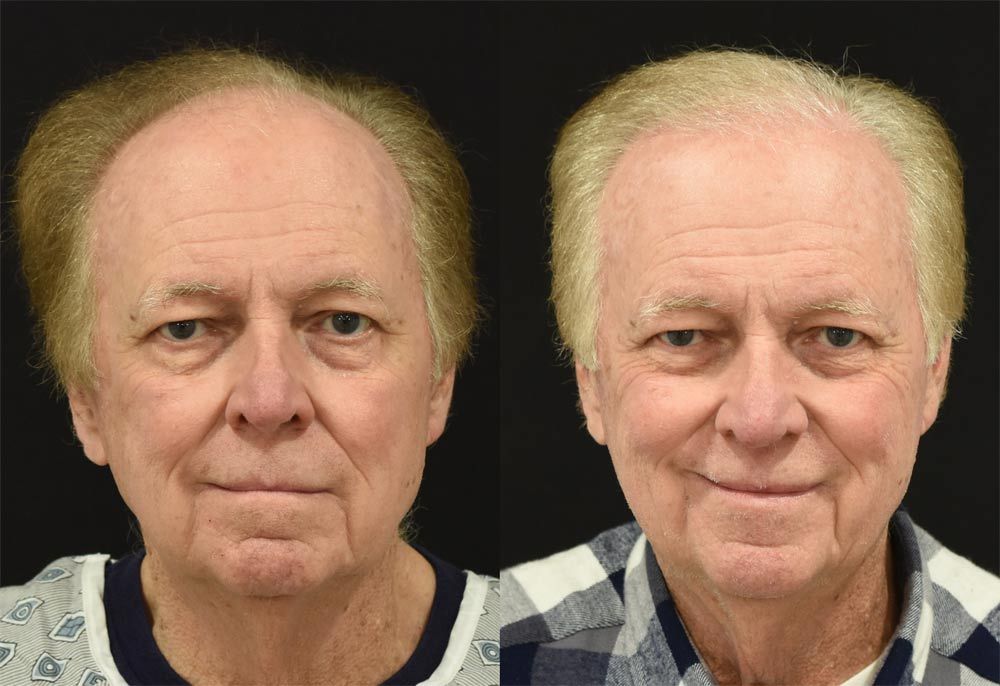Hair loss treatments can address specific concerns about the appearance of the hair on your scalp due to a condition called androgenic alopecia. There are three general categories of hair loss treatments for androgenic alopecia, each of which may or may not benefit you. It is important to first undergo an evaluation by a dermatologist to determine whether there are alternative causes to your hair loss, such as thyroid problems, vitamin deficiencies, infections, auto-immune conditions, or psychiatric illnesses. Seek not only a fellowship-trained but also a double board-certified facial plastic surgeon to help determine whether – and which – hair loss treatment is appropriate for your concerns once alternative causes have been ruled out.

Hair Loss Treatments: An Explainer
Dr. Jeffrey Harmon
Medications are Often the First Treatments Used for Hair Loss
Medical treatment is often the first treatment tried for hair loss and is an important adjunct to surgical and non-surgical procedures. The two most frequently administered medications for hair loss are finasteride and minoxidil.
Finasteride, which is available in oral and topical form, is generally prescribed to men only. Finasteride is an FDA-approved medication and an anti-androgen, meaning, it blocks the action of an enzyme called 5-alpha-reductase, which normally converts testosterone to other hormones that can cause hair loss. Finasteride is commonly prescribed for prostate enlargement. However, a much lower dose can be prescribed for hair loss. The topical form is less widely used but is sometimes combined with topical minoxidil.
Minoxidil in topical form is an FDA-approved treatment for hair loss. Unlike finasteride, it is commonly prescribed to women and men. There are multiple potential mechanisms for the function of minoxidil in treating hair loss.
It is important to note that, while finasteride and minoxidil can be effective treatments for hair loss, their effects last only if they are taken continuously. Hair is often lost again when these medications are discontinued.
There are also many treatments being marked for hair loss that are not FDA-approved. Most are regulated as nutritional supplements, which have significantly lower standards for effectiveness, safety, and consistency in formulation. For example, saw palmetto is a common ingredient in these products for men due to the limited evidence that it may function similarly to finasteride.
As with any medication, it is important to have a detailed discussion with your provider about the potential benefits, risks, and alternatives to the use of the medications and nutritional supplements above.
Non-Surgical Procedures for Hair Loss Can be Useful Adjunctive Treatments
One of the most popular and well-known non-surgical treatments for hair loss is platelet-rich-plasma (PRP). PRP, which is isolated from the patient’s own blood drawn the day of the treatment, is a concentration of platelets whose effects are “activated” when injected around the hair follicles in the patient’s scalp. Platelets release multiple signaling molecules that can help dormant hair start growing again. There is also evidence that PRP can improve the thickness of hair in some cases. Both men and women receive this treatment. It is typically administered once monthly for three sessions followed by a fourth session approximately six to eight months after the first. Treatments can be repeated every six to twelve months. Like hair restoration surgery, it typically takes a few months to notices the effects of this treatment. This treatment can be performed while taking medications and/or with hair restoration surgery to enhance the effects of treatment. PRP may benefit younger individuals who have less hair loss (e.g., mild-to-moderate) and/or who are not ready for hair restoration surgery.
Other injectable treatment options include products such as exosomes. Exosomes are membrane-bound structures that carry different materials, including proteins and mRNA. There have been some promising studies performed in cultures in a lab, but no good human studies performed to demonstrate the effectiveness of exosomes in the treatment of hair loss.
Another non-surgical treatment option is low-level light therapy. This involves the placement of a device over the scalp that emits red or near-infrared light. It requires multiple treatment sessions. It can also function as an adjunct to other treatments (e.g., PRP, hair restoration surgery, medications). The mechanism by which it can help treat hair loss is unclear and the evidence for its effectiveness is incomplete. However, like exosomes, it does show promise.
Surgical Procedures for Hair Loss are the Most Definitive Treatment for Hair Loss
Hair restoration surgery has advanced far beyond the unsightly – and obviously unnatural – “plugs” many people still associate with it. This is because techniques, technology, and our understanding of anatomy have improved greatly over the past twenty to twenty-five years. We have learned how to safely and effectively isolate miniscule groupings of hair follicles, called follicular units, and transplant them to other areas of the scalp to provide natural results for patients.
Much of the marketing behind hair restoration surgery is based on the device offered to perform this procedure. However, that is not the best way to explain hair restoration surgery to patients.
There are effectively two methods of surgical hair restoration surgery. Both operate on the understanding that hair follicles respond differently to their chemical environment on different areas of the scalp. There are some areas of the scalp where even individuals losing their hair tend to keep it, specifically over the ears extending to the back of the lower area of the head and nape. These hair follicles tend not to go dormant and disappear with the hormone-related changes that lead to androgenic alopecia. It is these hair follicles that are isolated and transplanted to areas of the scalp where hair is lost.
One approach to hair restoration surgery is follicular strip harvesting and transplantation, also called FUT. This procedure involves the removal of a thin strip of skin from the back of the head with the hair follicles intact followed by careful closure of this site so the surrounding hair can grow over the incision as it heals. This is usually the best initial approach – though there are always exceptions – to hair restoration surgery, because it can provide the largest concentration of follicles from the smallest harvested area. The follicles also tend to be healthier, less traumatized and, therefore, more likely to survive and grow.
The other approach is typically associated with the frequently marketed devices. Called Follicular Unit Extraction, or FUE, it differs from FUT in that a drilling device is used to isolate and extract individual follicular units rather than a strip with many follicular units. The harvested sites need to be spread evenly and randomly throughout a predefined area of the scalp. There are many different devices and many different drill shapes and sizes available for this procedure. FUE can be a good initial option if a patient wears their hair very short. Otherwise, it usually serves as an adjunct to FUT. For example, FUE can be used to harvest additional follicular units as needed if the FUT procedure falls short of the goal number of hair follicles. FUE can also be used for follow-up procedures when fewer follicular units are required.
It is important to note that the density of hair follicles available for an FUT procedure drops dramatically when the strip is harvested in areas where FUE has been performed. That it is why FUT is usually the best first option.
A commonly held concern among patients is the appearance of the hair follicle harvest site after surgery. There is a misconception that FUT can result in abnormal scarring and FUE cannot. FUT harvest sites are closed in multiple layers to minimize tension on the site. Hair is left in place around the surgical site to grow over it. As a result, few patients have noticeable scars after surgery. FUE results in small, pinpoint incisions that, if distributed properly, are generally minimally visible as well.
The procedure does not end with the harvest of hair follicles. The surgeon then determines the location, angle, and pitch the hair follicles will be placed on the scalp by creating “wells” in which the follicular units can be placed. A team of technicians isolates the follicular units and places them in these wells. This team is essential to the success of any hair restoration surgical procedure. The design of the hairline and the appropriate distribution and position of each follicular unit requires intense concentration, skill, and an artistic eye.
Medications such as topical minoxidil and non-surgical procedures including PRP and low-level light therapy are often incorporated into the procedure as adjunct treatments.
Like PRP, it takes months before these transplanted follicular units start growing hair. In fact, it usually takes one year before the final results are evident.
More than one session is often required to achieve ideal results. In fact, the International Society for Hair Restoration Surgery (ISHRS) surveys their members each year to learn more about hair restoration practice patterns. The 2021 statistics cited the average number of hair restoration surgery sessions required to achieve the ideal result was 1.4. A second session is more more likely required when there is little-to-no hair in the the area of the scalp transplanted, as demonstrated by the image of the patient below.
The patient below is six months out from FUT hair restoration surgery. He is expected to experience additional improvements in the appearance of his hair for at least six more months. A second FUT procedure was planned prior to his first surgery for one year after his first. The goal of his first FUT procedure was to establish his hairline as well as establish density at the center of his scalp. The goal of the second FUT procedure is to increase the density of his hair in the area that was previously transplanted and to build out hair in his temples.

Trust Your Face to a Facial Plastic Surgeon
It is important to seek a fellowship-trained specialist in plastic surgery of the face and neck when you have concerns about hair loss.
Why Choose Dr. Harmon
- The mission of Harmon Facial Plastic Surgery is to help people along their journey towards self-confidence, to feel good about feeling good.
- Dr. Harmon is a double board-certified facial plastic surgeon.
- Dr. Harmon values making patients feel welcomed, listened to, and respected.
- Dr. Harmon graduated with honors from Cornell University with a Bachelor of Science degree in molecular biology.
- Dr. Harmon earned his medical degree from the University of Cincinnati.
- Dr. Harmon underwent five years of extensive training in head at neck surgery at the prestigious residency program at the University of Cincinnati.
- Dr. Harmon then underwent focused fellowship training in cosmetic facial plastic surgery through the American Academy of Facial Plastic and Reconstructive Surgery (AAFPRS) with the world-renowned surgeon, Dr. Andrew Jacono, on Park Avenue in New York City.
Request a Consultation
Request a consultation with Dr. Harmon at Harmon Facial Plastic Surgery in Cincinnati. Visit our clinic. You will learn more about Dr. Harmon’s credentials, style, and approach. Build a relationship with our dedicated team. Do not stop at searching “plastic surgery near me.” Get in touch with us to learn more!
This blog post is for educational purposes only and does not constitute direct medical advice. It is essential that you have a consultation with a qualified medical provider prior to considering any treatment. This will allow you the opportunity to discuss any potential benefits, risks, and alternatives to the treatment.
